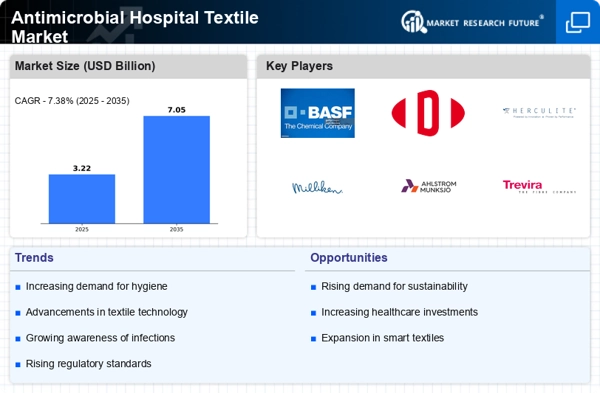Rising Demand for Healthcare Services
The increasing demand for healthcare services is a pivotal driver for the Antimicrobial Hospital Textile Market. As populations age and chronic diseases become more prevalent, healthcare facilities are experiencing heightened patient volumes. This surge necessitates the use of advanced textiles that can mitigate infection risks. According to recent data, the healthcare sector is projected to grow at a compound annual growth rate of approximately 7.5% over the next five years. Consequently, hospitals are investing in antimicrobial textiles to enhance patient safety and comfort, thereby propelling the market forward. The integration of these textiles into hospital environments is not merely a trend but a necessity, as they play a crucial role in infection control protocols. This growing emphasis on patient care quality is likely to sustain the demand for antimicrobial textiles in healthcare settings.
Increased Awareness of Infection Prevention
Increased awareness of infection prevention among healthcare professionals and patients is a critical driver for the Antimicrobial Hospital Textile Market. The recognition of the role that textiles play in the transmission of healthcare-associated infections has led to a greater emphasis on the use of antimicrobial fabrics. Studies suggest that the implementation of antimicrobial textiles can reduce infection rates by up to 30%, making them an attractive option for hospitals aiming to improve patient outcomes. This heightened awareness is fostering a shift in purchasing decisions, with healthcare facilities prioritizing textiles that offer enhanced protection. As educational initiatives and training programs proliferate, the demand for antimicrobial textiles is expected to rise, further solidifying their position in infection control strategies within healthcare environments.
Regulatory Support for Antimicrobial Products
Regulatory support for antimicrobial products is shaping the landscape of the Antimicrobial Hospital Textile Market. Various health authorities are establishing guidelines and standards that promote the use of antimicrobial textiles in healthcare settings. These regulations not only ensure the safety and efficacy of such products but also encourage manufacturers to innovate and comply with stringent quality benchmarks. For instance, the introduction of certifications for antimicrobial textiles is likely to enhance consumer confidence and drive market growth. As hospitals seek to align with these regulations, the demand for compliant antimicrobial textiles is expected to increase. This regulatory framework is essential for fostering a competitive market environment, where quality and safety are paramount, ultimately benefiting both healthcare providers and patients.
Growing Investment in Healthcare Infrastructure
Growing investment in healthcare infrastructure is a significant driver for the Antimicrobial Hospital Textile Market. Governments and private entities are increasingly allocating funds to enhance healthcare facilities, particularly in emerging economies. This investment often includes the modernization of hospital environments, where antimicrobial textiles are becoming a standard feature. Market analysis indicates that the healthcare infrastructure sector is anticipated to grow at a rate of 6% annually, with a substantial portion directed towards infection control measures. As new hospitals are built and existing facilities are upgraded, the integration of antimicrobial textiles is likely to be prioritized. This trend not only addresses the need for improved patient safety but also aligns with global health initiatives aimed at reducing infection rates in healthcare settings.
Technological Innovations in Textile Production
Technological innovations in textile production are significantly influencing the Antimicrobial Hospital Textile Market. Advances in nanotechnology and fiber engineering have led to the development of textiles that possess inherent antimicrobial properties. These innovations allow for the creation of fabrics that can withstand repeated laundering while maintaining their effectiveness against pathogens. Market data indicates that the antimicrobial textile segment is expected to witness a growth rate of around 8% annually, driven by these technological advancements. Furthermore, the introduction of smart textiles, which can monitor environmental conditions and respond accordingly, is likely to enhance the functionality of hospital textiles. As manufacturers continue to invest in research and development, the market is poised for substantial growth, with new products entering the market that meet the evolving needs of healthcare providers.


















Leave a Comment